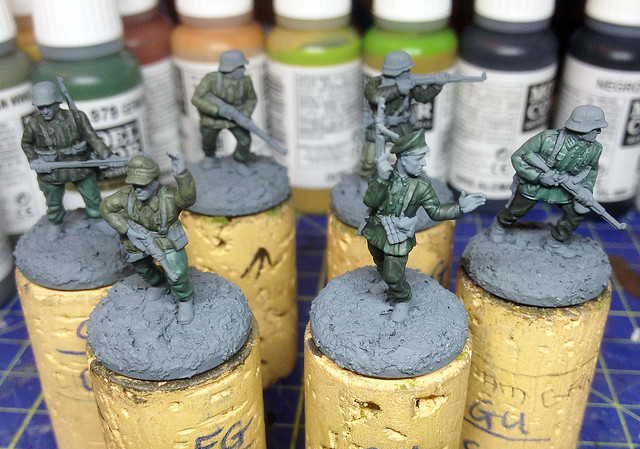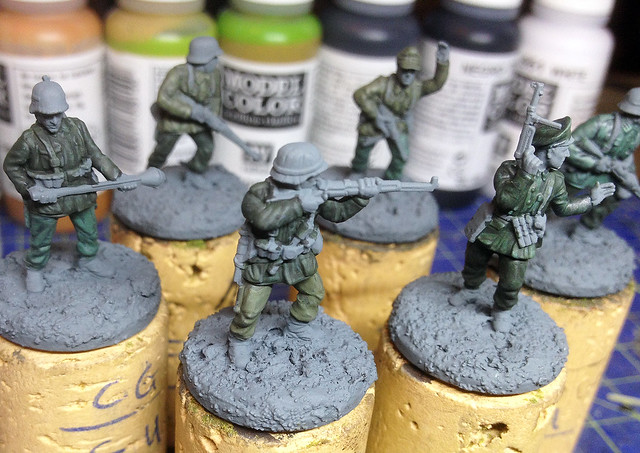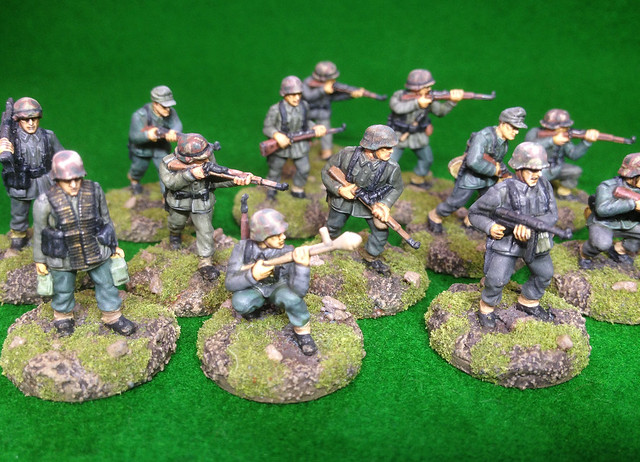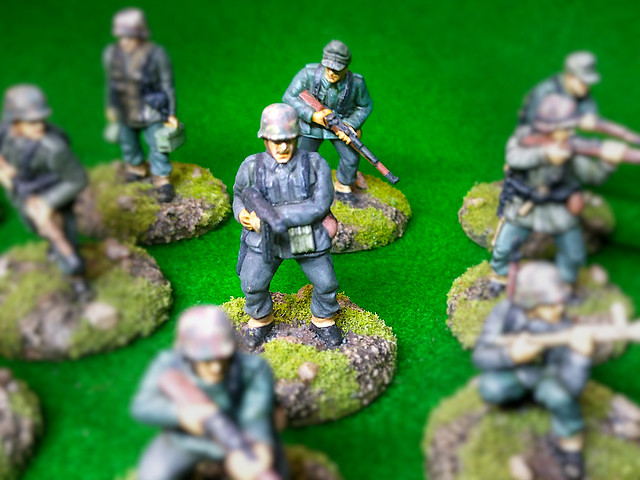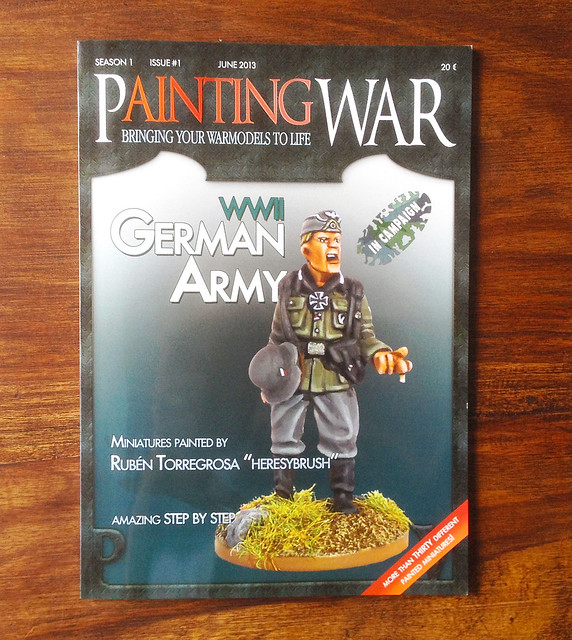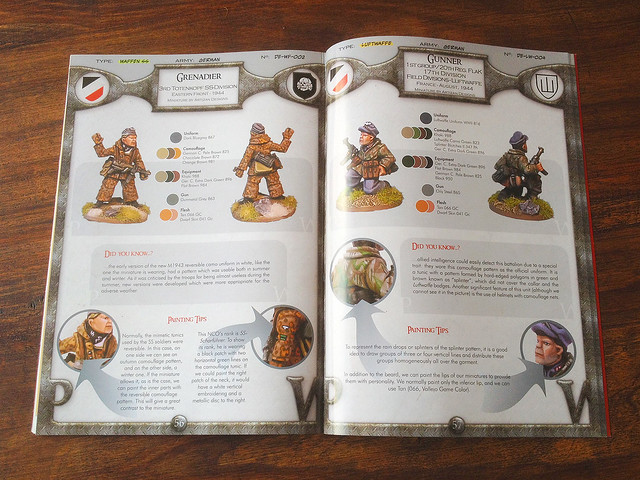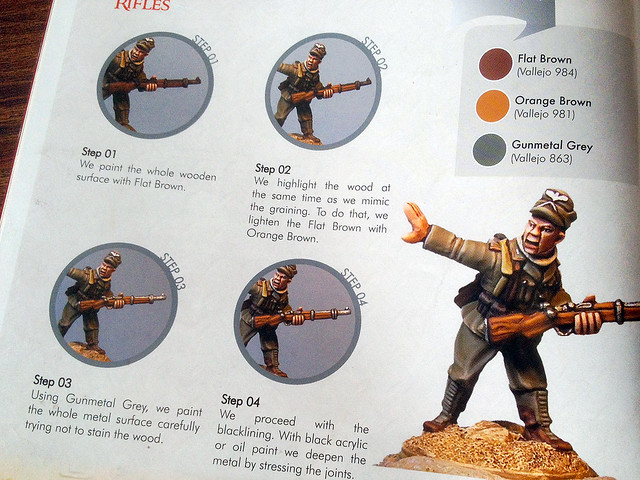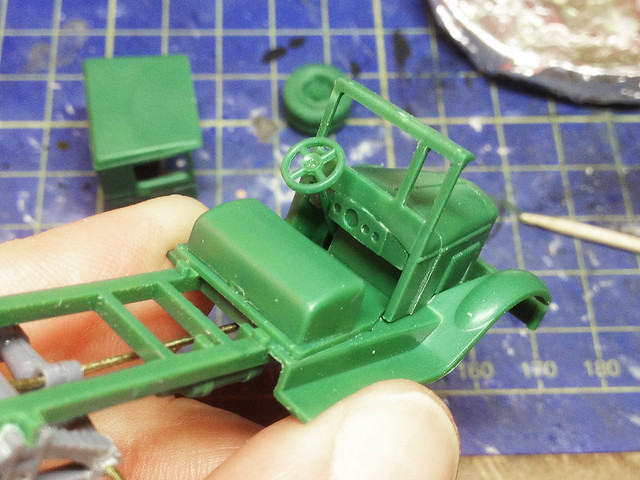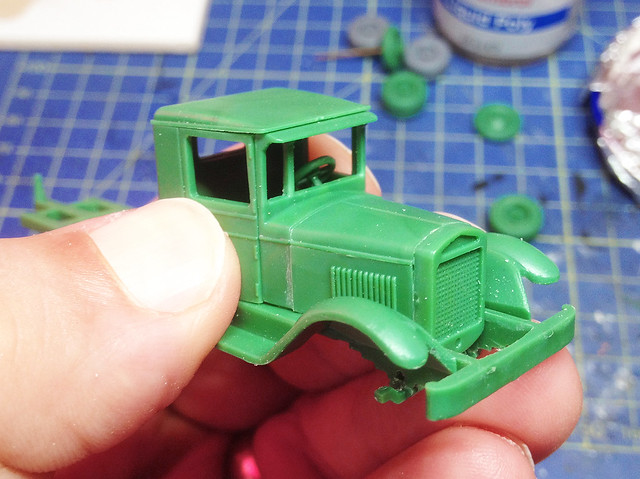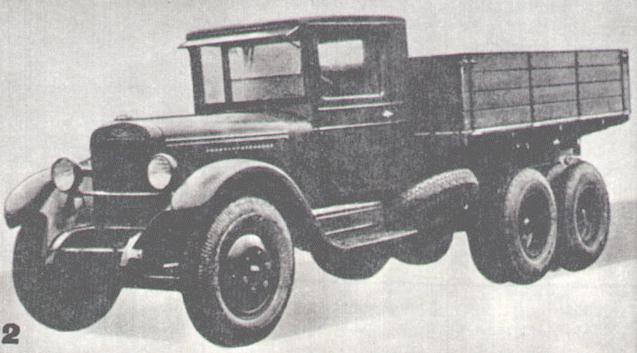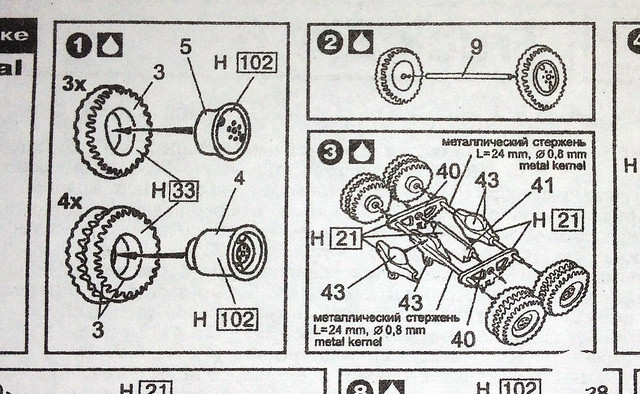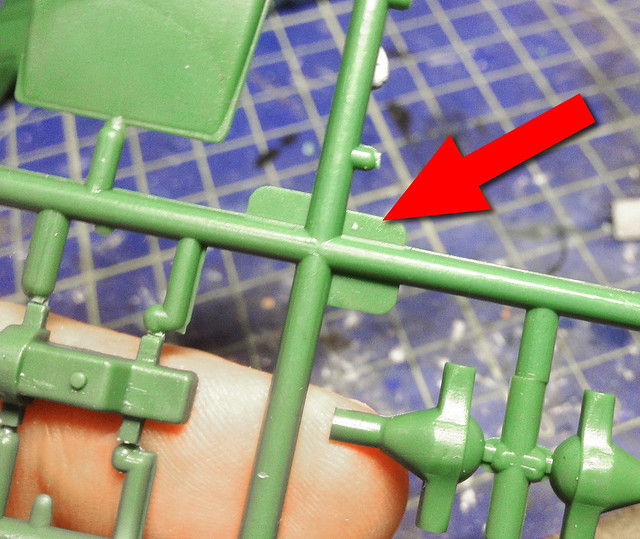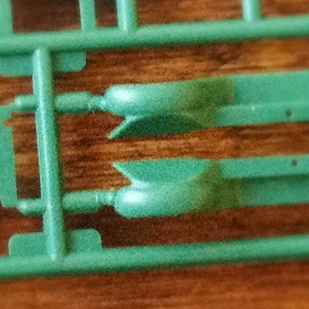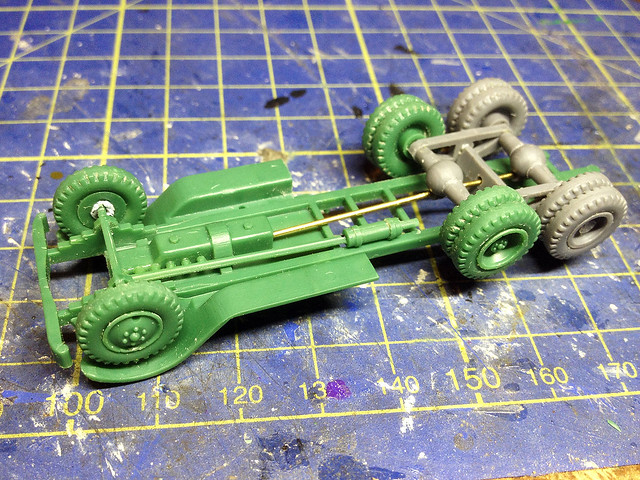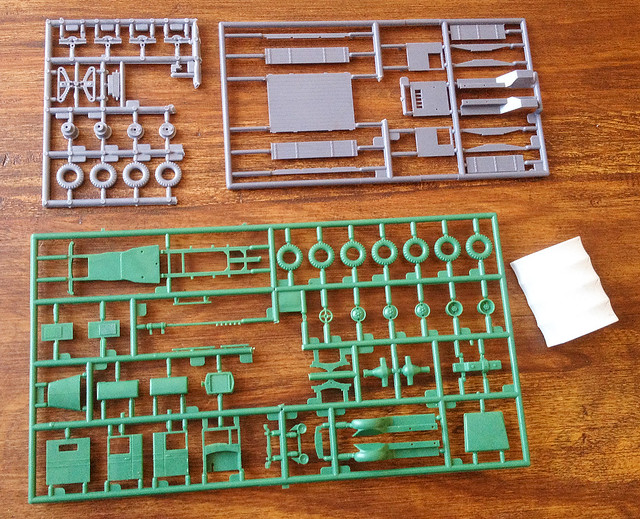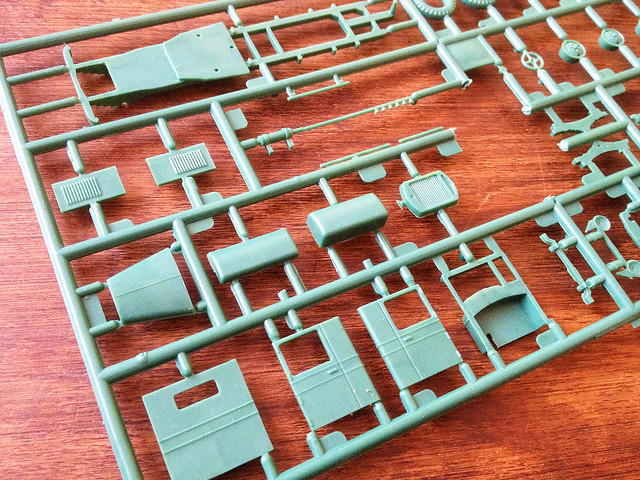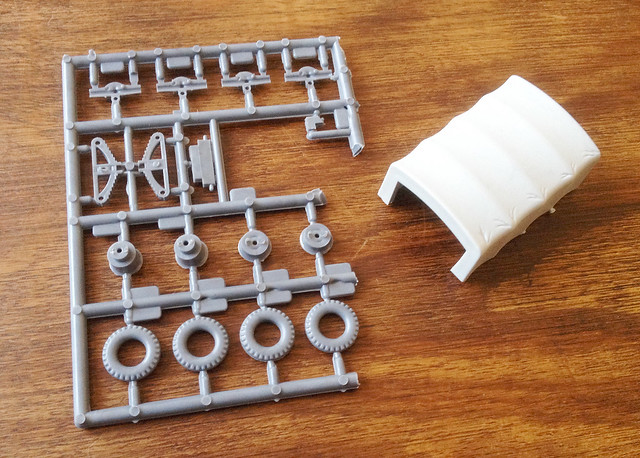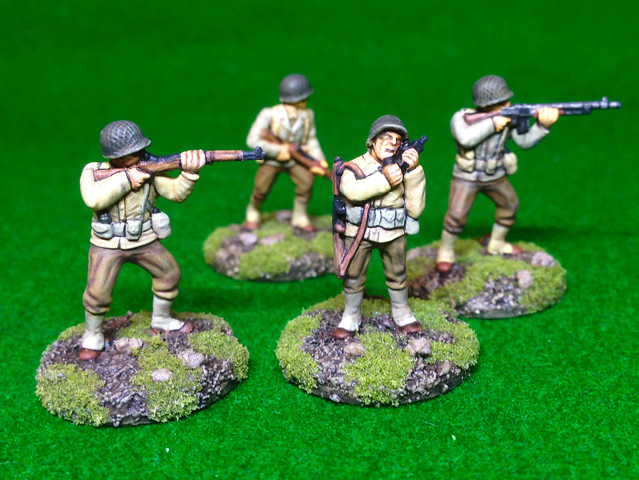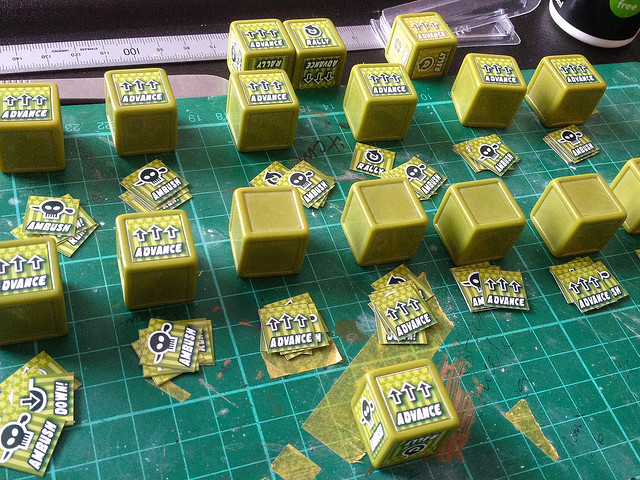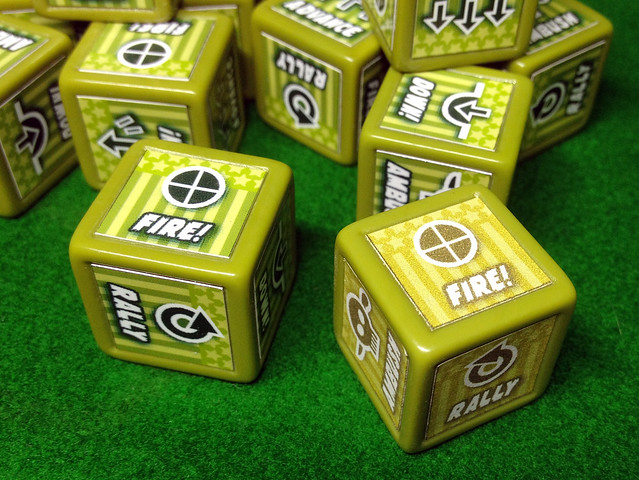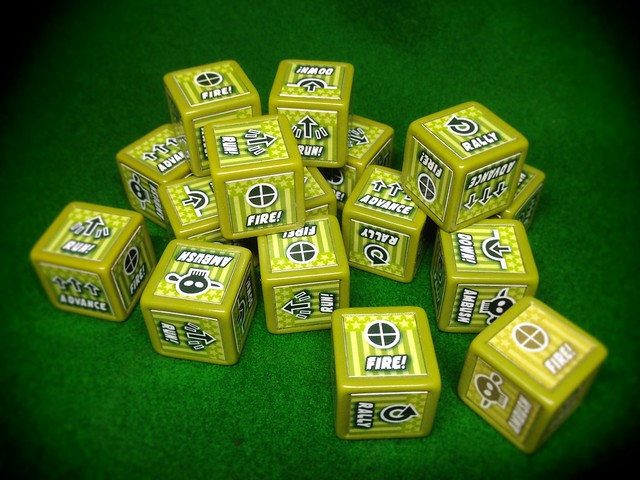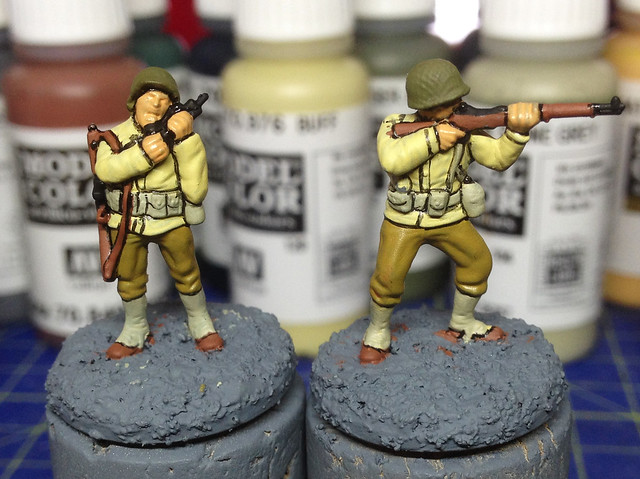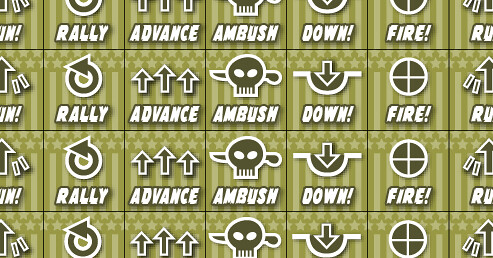My usual monthly glance at this blog's statistics shows that I have garnered a small Japanese audience! :)
As usual I am very grateful for any visitors to my rambling and ramshackle hobby blog and I do love to see where you all come from. America still leads the way stats wise (USA! USA!) ;) - with the UK naturally a large proportion of my little band of happy readers! :)
Thank you all for popping in and I do try my best to reciprocate visits where comments and links have been left. The visits from Japan particularly made me smile this morning (though I do love you all - in a manly fashion of course)!
Diary of a novice scale model maker and his adventures in the wacky world of Braille Scale.
Wednesday 28 May 2014
German Squad B - test figures
For my second squad of Germans I am trying out the painting techniques featured in Issue 1 of the 'Painting War' magazine. It's a bit more convoluted than the method I used with my initial squad, in fact it's almost the reverse procedure working, as it does, from a dark base coat to light - whereas I worked from a light base coat to dark!
At this point I am about halfway through the process (yes, just halfway) of painting the uniforms! There are more intermediate paint layers in this method than my simplified one - 6 shades as opposed to my triad of shadow/target/highlight. I am already a bit skeptical - but I guess this is the length to which top-class figure painters go to at this scale...Is it worth it for wargaming I have to ask?
As before I have gone for a rather 'shabby' look with my Germans, using a hotch-potch of mis-matched jackets and trousers colours. I really want a war-weary look rather than pristine parade ground uniform ensemble.
And also just as before, my variations on 'Field Grey' center around Vallejo's 920 German Uniform, 830 Field Grey and I am trying out 979 German Camo Green. All green tone themes, but going darker and lighter. While drab and subdued it still should make these figures suitably distinct from the colour scheme I am using for the Americans I am putting up against them.
At this point I am thinking my way was certainly easier and I think this method is a bit of overkill for 20mm figures and was really intended for the larger 28mm figures that are used for Bolt Action.
At this point I am about halfway through the process (yes, just halfway) of painting the uniforms! There are more intermediate paint layers in this method than my simplified one - 6 shades as opposed to my triad of shadow/target/highlight. I am already a bit skeptical - but I guess this is the length to which top-class figure painters go to at this scale...Is it worth it for wargaming I have to ask?
As before I have gone for a rather 'shabby' look with my Germans, using a hotch-potch of mis-matched jackets and trousers colours. I really want a war-weary look rather than pristine parade ground uniform ensemble.
And also just as before, my variations on 'Field Grey' center around Vallejo's 920 German Uniform, 830 Field Grey and I am trying out 979 German Camo Green. All green tone themes, but going darker and lighter. While drab and subdued it still should make these figures suitably distinct from the colour scheme I am using for the Americans I am putting up against them.
At this point I am thinking my way was certainly easier and I think this method is a bit of overkill for 20mm figures and was really intended for the larger 28mm figures that are used for Bolt Action.
Monday 26 May 2014
PST ZIS-6 Truck - Base coat
As much as I intend to do this weekend - the basic paint coat. I really like Humbrol's Light Olive, it's a smashing base for a variety of olive drab vehicles for a variety of nations as it can be modulated into a multitude of hues. Plus it's great for doing a slightly faded or sun-bleached green...
I can now start to plan how I want to weather this model. As this was a captured vehicle and saw a lot of hard use from 1941 to 1944 I am thinking a heavily worn and weathered look will be suitable. As usual I do look around the web to see what other people have done and while there aren't many ZIS-6s there are plenty of ZIS-5s, including this very nice example by Gulumik Miltary Models...
As you can see with the above example Humbrol's Light Olive is a good light base to start with before you begin to modulate and shade with darker tones. Gulumik have made a lot better job of gluing in their windows though, I made a bit of a mess of mine but may be able to disguise this with some dust sprayed onto the glass.
Finally, I have - as I intended when I started this project - built this model 'out the box', I haven't made any improvements or modifications. There are a few easy improvements you can make - like the headlamps and their fitting - but I really just wanted to relax and make a vanilla kit for a change.
I can now start to plan how I want to weather this model. As this was a captured vehicle and saw a lot of hard use from 1941 to 1944 I am thinking a heavily worn and weathered look will be suitable. As usual I do look around the web to see what other people have done and while there aren't many ZIS-6s there are plenty of ZIS-5s, including this very nice example by Gulumik Miltary Models...
 |
| Source: Gulumik Miltary Models |
Finally, I have - as I intended when I started this project - built this model 'out the box', I haven't made any improvements or modifications. There are a few easy improvements you can make - like the headlamps and their fitting - but I really just wanted to relax and make a vanilla kit for a change.
Sunday 25 May 2014
PST ZIS-6 Truck - Flatbed & windscreen
This progresses nicely. I am quite pleased with the general quality of this PST kit - especially when I compare it to my previous experiences of the other Eastern European kits I have made from MW and ACE - and I will certainly buy more from the PST range.
Time to put all the components together for the first time and have a look at what the truck looks like. It really does look a bit of a mongrel with all the various colours of plastic PST uses for this kit BUT it all works in the end and that's all that matters...
Onto the flatbed, there isn't a lot to it but it fits together well enough. While making this I also added a driver figure and painted the inside of the cab, the driver was just a random figure I had laying around and isn't the best but I guess you won't see that much of him...
I have decided - after much consideration - to make and fit the transparent plastic windscreens before I glue the cab together - just to make it easier to install the 'glass'. This does mean that I will have to mask the windscreens before I spray the truck body with it's primer coat, but that isn't a big deal.
As I said earlier, luckily all the windows in the ZIS are rectangular so there is no complicated cutting out to do and as usual I will be using Formula '560' canopy glue to stick the transparent plastic in place (although I am still unsure what advantage this has over cheap PVA glue).
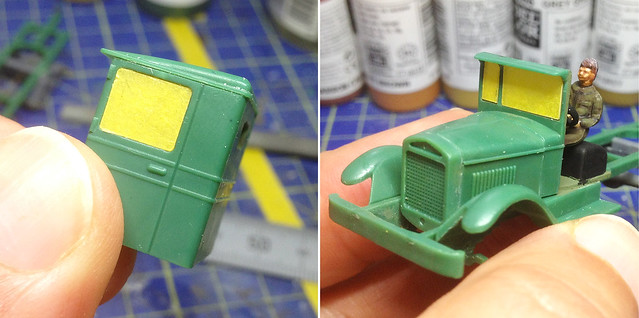 |
| I've used masking tape to protect the transparent plastic during fitting and during the base coats spraying phase (which is next). |
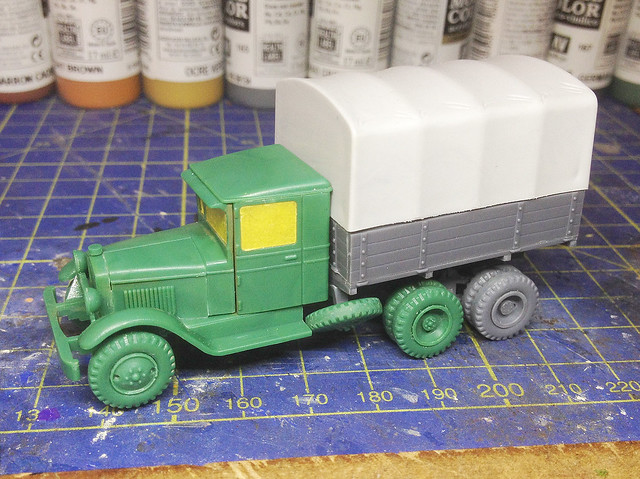 |
| All the major components are just dry fitted, I will be disassembling the truck again in order to spray on the base coat of Humbrol Light Olive. |
It really is a handsome little truck and I am sorely tempted to get some more of these (especially as they come in so many variants), but I will have to leave that until my Finnish project is done as I now more or less have filled my truck inventory for that now. Still, I have the PST ZIS-5V still to make for this project and that's almost exactly the same kit but with a single rear axle!
Next: Base coat.
Next: Base coat.
Friday 23 May 2014
Bolt Action DIY Order Dice - German
Piddling about with those dice again (by the way, why do they call them dice, because you don't roll them), this time I'm working on the design for the German set. I've come up with two designs, a subdued design and a high contrast design...
Printing onto glossy paper is a real pain in the ass as the colours never turn out quite how they imagine they will. The subdued design is supposed to be a mid grey - so you can see the German across faintly in the background - but instead it's turned out to be this rich dark-bluish tone (so sorry if you've downloaded my file for this and found it to be too dark).
Funnily enough I now like the high-contrast version I did with the red background.
I think what I will do if design a lighter grey version of the subdued design OR issue the file as a Photoshop .psd so people can alter the darkness or the design themselves to suit their particular printer/paper combination.
I think I might make a full set of the red labels for my Germans.
Printing onto glossy paper is a real pain in the ass as the colours never turn out quite how they imagine they will. The subdued design is supposed to be a mid grey - so you can see the German across faintly in the background - but instead it's turned out to be this rich dark-bluish tone (so sorry if you've downloaded my file for this and found it to be too dark).
Funnily enough I now like the high-contrast version I did with the red background.
I think what I will do if design a lighter grey version of the subdued design OR issue the file as a Photoshop .psd so people can alter the darkness or the design themselves to suit their particular printer/paper combination.
I think I might make a full set of the red labels for my Germans.
Thursday 22 May 2014
Bolt Action - First German unit!
Completed 'Squad A', my very first full Bolt Action unit (I need to get at least another like it to make a viable playable force - and, of course, make a similar opposing force to get a game going). So still a bit of work to do before I can start really learning Bolt Action with a couple of basic forces.
More importantly, perhaps, is that this is my very first completed 1/72 set of figures! Hooray!
Overall I'm relatively satisfied with the results of my amateurish painting experimentation. Everything has been done on a 'suck it and see' basis, I haven't developed a method for painting figures as yet (but I'm working on that and we shall see if there are noticeable improvements when I get around to painting Squad B). In particular I am having a hard time with faces.
Obviously I have a lot to learn about painting figures and I'm a bit annoyed that when I varnished my guys the matt varnish - naturally - dulled down some of the vibrant colours and left them looking a bit 'flat'. Next time I may try a satin finish, just to perk the colours up a little bit.
However, on a more positive and less self-critical note, I am quite pleased with the job I made of the battle-weary dulled down camo and the equipment...
I noticed - when looking at other Bolt Action painted figures done by others - that there seems to be a trend to making colours a little more vivid. I kinda get this as - in my opinion - Bolt Action is kind of a 'comic strip' sort of game - it's like a game version of those Commando or Battle comics that I used to read as a kid. Everything is larger than life and a little - frankly - silly (I mean that in a nice fun way).
I hope Bolt Action fans who read this will not be offended!
Having vivid and brightly painted army uniforms makes sense from a tabletop game point of view simply so players can quickly recognise which infantry is which on the table. Dulled down and drab uniforms might seem more historically accurate but then it becomes a little harder to tell infantry apart then. But it's all a matter of taste (they are your soldiers) - mine are a little duller and battle-worn.
Wednesday 21 May 2014
Painting War - WW2 German edition
Unfortunately I discovered the book after I had already started painting my Bolt Action Germans, but hey-ho! Now, this book is a little hard to track down now, it seems it was pretty quickly snapped up when it was published and now I have it I am not surprised whatsoever. It's pretty awesome!
I had to send away to a Spanish retailer to get my hands on a copy (thank you Google Translate) and it took so long to arrive that I actually finished my first squad of Germans by the time it flopped onto my hallway carpet. But it didn't take more than a quick flick through it's pages to realize that this was a very valuable reference that will help me improve my model soldier painting...
The bulk of the tutorials in this book - and I'd say it was a book rather than a mere magazine - are intended for 28mm figures of the Bolt Action format (though there is a tutorial especially for 15mm, 20mm fans like myself will have to cherry pick techniques that apply to their scale). As the title suggests it is specifically aimed at WW2 German forces - Heer (Army), Luftwaffe paratroopers, Africa Corps and - always controversially (IMHO) - the various SS Divisions. But fear not, I will not go off on any sort of rant about the latter (and why on earth you would want to play this formation).
Aside from painting guides there is a lot of other information that is very useful, like the guide to insignia and ranks in the various German formations...
There are over 70 pages of full colour illustrations covering the paint schemes of over 30 different painted miniatures. Very usefully the author includes Vallejo colour swatches to accompany the various illustrations so you know exactly what colour he used to paint a uniform or piece of equipment.
I was very impressed with this publication and glad I tracked it down and forked out the money for it. Although it seems - on the surface - to be pretty specific, being about WW2 Germans, in fact a lot of the techniques are applicable for many of the armies during WW2 period and certainly very useful for my current projects for Bolt Action.
I bought my copy from Breakingwar.com and cost me €20 plus shipping. It is the first edition in a series and so I am not sure how many more are available so I strongly recommend you snap up a copy if you can, you won't regret it.
PST ZIS-6 Truck - cab & bonnet
For once there isn't much to say! Things went fairly much as the instructions described. Fit was the main niggle - a little sloppy but not horrendous...
The main cab and bonnet components - above - are quite chunky and the detail is basic but the radiator grill is nice. But as you can see with the interior detail PST have just done the bear minimum...
Nothing didn't fit, but there were a few gaps...But hey, it's a Soviet wartime vehicle so what do you want! By the way, I'm not glueing the cab together yet as I will need to paint the interior (and add a driver) before I close it up...
Not bad though eh? It's a fun little vehicle to make as it has plenty of character. Reminds me of The Waltons! Grandpa Walton could have shifted a lot of wood with one of these...
Well, as least he could once I have fitted the flat bed, which is what I'm doing next.
The main cab and bonnet components - above - are quite chunky and the detail is basic but the radiator grill is nice. But as you can see with the interior detail PST have just done the bear minimum...
Nothing didn't fit, but there were a few gaps...But hey, it's a Soviet wartime vehicle so what do you want! By the way, I'm not glueing the cab together yet as I will need to paint the interior (and add a driver) before I close it up...
Not bad though eh? It's a fun little vehicle to make as it has plenty of character. Reminds me of The Waltons! Grandpa Walton could have shifted a lot of wood with one of these...
Well, as least he could once I have fitted the flat bed, which is what I'm doing next.
Monday 19 May 2014
PST ZIS-6 Truck - wheels & axles
What looked like nice clean and crisp component parts turned out to be a little sloppy when it came to construction. Everything that came off the sprues seemed to need a little filing to clean them up and make them fit -- not big job you understand and everything did fit, but just niggling little preparation.
As mentioned in the in-box review f this kit there are a number of additional parts and this did indeed cause some little confusion in the construction. No sooner had I started sorting out the various parts for the wheels and axles that I ran into two little problems, the bigger of which was that I could not locate the axles!
You see the instructions are largely pictorial, but do have - frustratingly - the odd important notation in Russian! So I hunted for parts that looked like they were axles - basically plastic rods (I thought) - only to realise after some time that the little Russian notations in panel (2) of the instructions were - in fact - telling me that I had to cut my own axles out of some metal rods (of my own)! Grrrrrrrr!
...And then, as if things weren't confused enough there was the little matter of the part numbers - like those shown in the instructions above - or should I say the lack of them...
No, I haven't got the sprue the wrong way around - the part numbers just aren't there!
Still, these were only minor - if somewhat annoying - hiccups and I soon muddled my way through the construction of the wheels, axles and rear suspension...
Note the mixed colours of the parts, the green wheels come from the basic ZIS-5/V sprue (see in box review) and the gray parts are from the ZIS-6 sprue. The DIY 'axles' are some lengths of scrap brass rods I happened to have (luckily).
The wheels themselves are - as you can see - one-piece plastic components which is good and bad. Bearing in mind the horrendous experience I had with my ACE BA-10 kit's vinyl tyres I was somewhat relieved to have plastic wheels, but there again there is not so much detail on these plastic 'tyres' and no tread pattern whatsoever. :(
Now on to the chassis, but - again - there is a little niggle which seeks to frustrate the modeller.
The main fenders (mud-guards to we Brits) are attached to the main (green) sprue in the most annoying fashion with a sprue attachment right on the apex of the front of the rounded mud-guard! OK, this - again - isn't a biggie but is worth mentioning as you have to be careful detaching it and then do some filing to get the rounded end into shape.
Are PST trying to upset me? This was - after all - supposed to be a simple and straight forward build!
Well, the chassis turned out to be a bit more straightforward with no real surprises, which was nice. Though there were some more brass rods required, but at least I now knew what the Russian notation meant in the instructions so wasn't confused by the absence of suitable parts on the sprues.
I decided not to glue the wheels onto the axles permanently yet as I want to be able to spray these parts individually before final assembly. Similarly I haven't glued on teh mud-guards either, as I want to spray the chassis black and the fenders green and having them separate will make this easier.
Well, that's that. Aside from the slight confusion regarding the addition of your own axles by means of some brass rod it was all pretty simple. Though there will still need to be some tidying up when I glue together everything permanently - and balance the rear wheels on their axles too so they are perfectly level.
Next: The cab and the bonnet.
Saturday 17 May 2014
PST ZIS-6 Truck - in-box review
It seems that if you are modelling WW2's Eastern Front sooner or later you will build a ZIS or GAZ truck. It's inevitable! And so the time has come for me to try my hand at one of these charming little vehicles in the form of PST's ZIS-6 medium truck...
The Soviet ZIS-6 was the 3-axle version of the ZIS-5 light truck (which I will be making at a later date) and was a 2.5 ton 6x4 transport which could haul up to 4 tons on a highway. Because of this heavier load capacity I have chosen this model as one of the trucks for my Finnish medium artillery formation.
In terms of war game modelling this heavier truck is not as familiar a build as it's smaller sibling - the ZIS-5 - or it's GAZ compatriot. But it is available in kit form in wide number of variants - mainly by PST - which range from this cargo version to an ambulance version, to self-propelled anti-aircraft truck, to mobile workshop to the famous (or infamous) "Katyusha" rocket launcher.
What's in the box?
As with my last PST model - thier 1943 Ford 6 Truck - there are a hotch-potch of coloured sprues in the box (which is a little bemusing at first). As usual PST seem to 'mix and match' a basic set of sprues with additional ones to make variants of the basic model - hence the different colours.
The amusing up-shot of this is that you tend to end up with additional parts that aren't meant for the model you have actually bought! With my PST Ford I ended up with several (useless) Studabaker parts, and with the ZIS-6 I have ended up with a superfluous wooden cab which I *think* is intended for the ZIS-5V light truck! :)
However, the reason you end up with these extra parts is because there are parts on this particular sprue that you do need...Bizzarre! Obviously PST are saving money and realised that the flat bed parts which come with the ZIS-5 kit also happen to be the the same size as the flat bed parts required for the ZIS-6.
Anyway, you can't really complain about extra parts, even if it makes things a little confusing at first.
The quality of the moulding is lovely, it's nice and sharp and detail is well defined and there is a complete absence of any flash (at least on my model). Nice!
The two other parts I do not mention here are the decal sheet and the windows. Well, I didn't mention the windscreen because the kid doesn't come with one! You will have to make your own glass out of some clear plastic...Luckily the shape of the windscreen is pretty much rectangular, so it's not a difficult job.
Then there are the instructions, which is one A4 double sided photocopied sheet. Now this isn't such a big deal, but with relation to the decals in particular the lack of a colour-scheme guide is a bit of a annoyance.
Now, sorry about my terrible photography but there isn't that much to see really. I *think* there are enough decals to make a choice of four different vehicles, but as there is no information about these decal choices I have no idea what machines these were, what regiments or where they served! (Just as well I am making a captured Finnish version of the truck isn't it!)
And that's about it really. It looks all pretty straight forward - even with the extra parts thrown in - and I have to say that it will be nice to make a simple model for a change (with none of my usual dodgy conversions or 'improvements'! :)
Looking at it now - before construction - it all looks very nice. So...Let's get ready to rumble!
Link: The ZIS-6 at Engines of the Red Army
------------------------------------------------------------------------------
Postscript: Curious about the extra parts - and what they were - I checked back to the 'in box' review I did when I bought my PST ZS-5V, and guess what? Exactly the same basic sprues appear in this kit!
In fact the only difference between the PST ZIS-5V and the ZIS-6 kit is - naturally - the smaller sprue which provides the rear axles and extra wheels that the ZIS-6 has and a tilt cover.
This makes me very tempted to make both related truck kits at the same time, or do the ZIS-5/V after I do the ZIS-6. Incidentally, you also get two kits in one in the PST ZIS-5/5V kit. It comes with all the parts to make the basic (earlier) metal cabbed ZIS-5 and then an extra sprue to make the (later) wooden cabbed ZIS-5V.
All this means that if you do buy a PST kit expect some bits and pieces that you can put in your spare parts box! :)
The Soviet ZIS-6 was the 3-axle version of the ZIS-5 light truck (which I will be making at a later date) and was a 2.5 ton 6x4 transport which could haul up to 4 tons on a highway. Because of this heavier load capacity I have chosen this model as one of the trucks for my Finnish medium artillery formation.
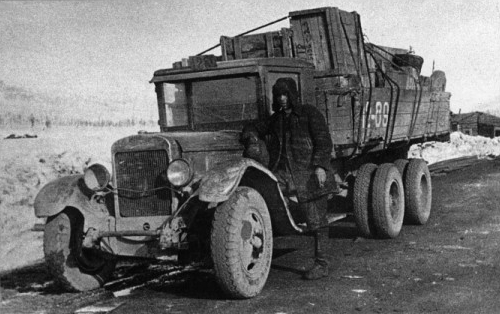 |
| Source: Wikipedia |
What's in the box?
As with my last PST model - thier 1943 Ford 6 Truck - there are a hotch-potch of coloured sprues in the box (which is a little bemusing at first). As usual PST seem to 'mix and match' a basic set of sprues with additional ones to make variants of the basic model - hence the different colours.
The amusing up-shot of this is that you tend to end up with additional parts that aren't meant for the model you have actually bought! With my PST Ford I ended up with several (useless) Studabaker parts, and with the ZIS-6 I have ended up with a superfluous wooden cab which I *think* is intended for the ZIS-5V light truck! :)
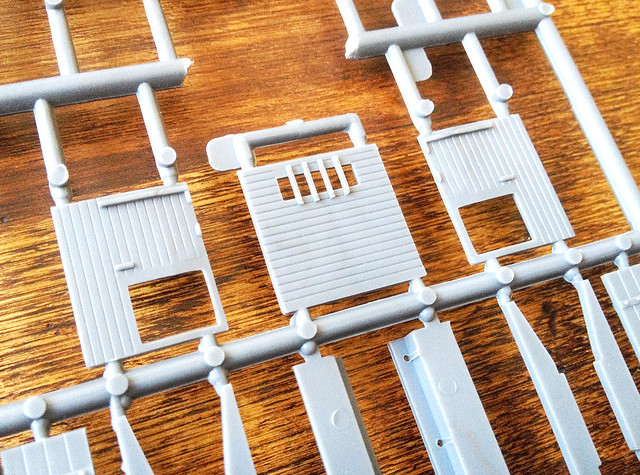 |
Anyway, you can't really complain about extra parts, even if it makes things a little confusing at first.
The quality of the moulding is lovely, it's nice and sharp and detail is well defined and there is a complete absence of any flash (at least on my model). Nice!
Then there are the instructions, which is one A4 double sided photocopied sheet. Now this isn't such a big deal, but with relation to the decals in particular the lack of a colour-scheme guide is a bit of a annoyance.
Now, sorry about my terrible photography but there isn't that much to see really. I *think* there are enough decals to make a choice of four different vehicles, but as there is no information about these decal choices I have no idea what machines these were, what regiments or where they served! (Just as well I am making a captured Finnish version of the truck isn't it!)
And that's about it really. It looks all pretty straight forward - even with the extra parts thrown in - and I have to say that it will be nice to make a simple model for a change (with none of my usual dodgy conversions or 'improvements'! :)
Looking at it now - before construction - it all looks very nice. So...Let's get ready to rumble!
Link: The ZIS-6 at Engines of the Red Army
------------------------------------------------------------------------------
Postscript: Curious about the extra parts - and what they were - I checked back to the 'in box' review I did when I bought my PST ZS-5V, and guess what? Exactly the same basic sprues appear in this kit!
In fact the only difference between the PST ZIS-5V and the ZIS-6 kit is - naturally - the smaller sprue which provides the rear axles and extra wheels that the ZIS-6 has and a tilt cover.
This makes me very tempted to make both related truck kits at the same time, or do the ZIS-5/V after I do the ZIS-6. Incidentally, you also get two kits in one in the PST ZIS-5/5V kit. It comes with all the parts to make the basic (earlier) metal cabbed ZIS-5 and then an extra sprue to make the (later) wooden cabbed ZIS-5V.
All this means that if you do buy a PST kit expect some bits and pieces that you can put in your spare parts box! :)
Wednesday 14 May 2014
The Yanks are coming - Test finals
I completed the test figures. I am quite happy with the outlining technique but I really have to practise painting faces. I don't have a good technique for doing faces yet unfortunately.
The uniforms seemed to work out well in the end - bizarre that I got this by reversing the main colours suggested by PSC! (The jacket is now painted in the webbing colour and the webbing is the colour intended for the jacket!)
The uniforms seemed to work out well in the end - bizarre that I got this by reversing the main colours suggested by PSC! (The jacket is now painted in the webbing colour and the webbing is the colour intended for the jacket!)
Monday 12 May 2014
Bolt Action - DIY Order Dice complete
Although the sticky label method was a quick and easy way to make the labels for my dice I wasn't happy with the quality of the finished print. The label paper isn't a smooth medium and also absorbs the ink making the design look washed out. So I decided to revert to the simple way of making the labels using an ordinary glossy photo paper.
So having printed out the dice labels I had to chop up the sheet and then start the job of gluing them - using PVA - to the plastic dice (I'm making two sets, one for my brother and one for me)...
Here you can see the difference in quality between my original idea - using sticky labels - and the photo paper version...
I did have to adjust the colour of my design slightly to work with the gloss paper but the end product looks richer and sharper...
I'm quite pleased with these really - dare I say I *think* they are a little more attractive than the proper dice (which are a lot more expensive). Plus I get to have customised designs which are a bit more recognisable as belonging to the national army that they are supposed to represent.
Now I'll have to do the order dice for my Germans! :)
FACE-PALM UPDATE: Just had a message from a reader asking 'why didn't you just use double-sided sticky tape instead of PVA?' ....Er, 'Du-oh'! :)
So having printed out the dice labels I had to chop up the sheet and then start the job of gluing them - using PVA - to the plastic dice (I'm making two sets, one for my brother and one for me)...
Here you can see the difference in quality between my original idea - using sticky labels - and the photo paper version...
I did have to adjust the colour of my design slightly to work with the gloss paper but the end product looks richer and sharper...
I'm quite pleased with these really - dare I say I *think* they are a little more attractive than the proper dice (which are a lot more expensive). Plus I get to have customised designs which are a bit more recognisable as belonging to the national army that they are supposed to represent.
Now I'll have to do the order dice for my Germans! :)
FACE-PALM UPDATE: Just had a message from a reader asking 'why didn't you just use double-sided sticky tape instead of PVA?' ....Er, 'Du-oh'! :)
Sunday 11 May 2014
The Yanks are coming - revised colours
Unhappy with PSC's suggested colours scheme for their Late War American infantry I decided to take the advice of one of my readers and reverse the colours! Originally PSC had advised that Vallejo's Stone Grey (884) be used for the American's jacket and that Buff (976) should be used for teh webbing and spats - I swapped these around...
Another thing I am continuing to experiment is the black outlining that I tried out with my original test figures. This feels very strange to someone with a classical art training - I remember vividly an early art class where I was admonished by a teacher for using heavy outlines!
However, the consensus of opinion was that the test figure that I used this technique on was the better of the two. Who am I to ignore the democratic process? :)
Once the 'comic book' outlining was done I started to blend in paint in order to make this aggressive shading less harsh...
The new revised colours are now closer to what I think were - historically - the right ones (referring to my Osprey reference book).
I still have to finish the shading off but I'm happier with the scheme now and will roll it out across the rest of my squads. Incidentally, the problem I had with the trousers colour - US Field Drab (873) - seems to have been in some small part to do with the white primer I used on my first two test figures. This time, with a grey primer, it went on as intended.
Next: Well, not much for a while - I want to finish my first set of Germans first!
 |
| The new colour scheme for my Yanks - behind them you can see my two original test figures in PSC's recommended uniform scheme. |
However, the consensus of opinion was that the test figure that I used this technique on was the better of the two. Who am I to ignore the democratic process? :)
Once the 'comic book' outlining was done I started to blend in paint in order to make this aggressive shading less harsh...
 |
| On the left my original attempt at painting and outlining, on the right my latest go. A bit tidier this time. Practise makes perfect (eventually) I guess! |
I still have to finish the shading off but I'm happier with the scheme now and will roll it out across the rest of my squads. Incidentally, the problem I had with the trousers colour - US Field Drab (873) - seems to have been in some small part to do with the white primer I used on my first two test figures. This time, with a grey primer, it went on as intended.
Next: Well, not much for a while - I want to finish my first set of Germans first!
Saturday 10 May 2014
Bolt Action - DIY Order Dice
I finished of my design for some Order Dice today and so had a go at trying them out on some of the blank dice I bought. I duplicated the designs onto the template I downloaded from the Blankdice.co.uk web site (each square design being 14.3mm square to fit into the indented side of the dice).
There are actually two slightly different designs on this sheet - the one highlighted above and a simpler less fussy one - as I wasn't sure how clear the illustration would be once I printed it out. I had a bit of a think about how best to stick the designs onto the plastic dice and decided to try printing the design onto some sticky labels!
I didn't really fancy messing around with PVA glue and lots of small paper squares. Also, I thought that these labels might be easier to peel back off again if I didn't like them.
The hardiness of these prints did worry me a bit and I considered covering them with some clear sticky-backed plastic to help protect them. We shall see how long they last in use.
The labels I used were large A4 ones so there wasn't an issue with lining up the paper and it went through my printer OK. Though I did have a problem with the printer driver I was using as I couldn't seem to change the print quality and it went through as 'normal' instead of the higher quality I wanted (I will have to Google this to see what the problem is). :(
Still, they weren't too bad and the sticky label worked really well. The other way I could have done it was to print them onto a glossy photo paper and cut and stuck these on. Maybe I will try this and also see if I can solve my printer problems.
Next: On to my German Order Dice designs then I will post up the templates so anyone who likes teh designs can download them.
Subscribe to:
Posts (Atom)
